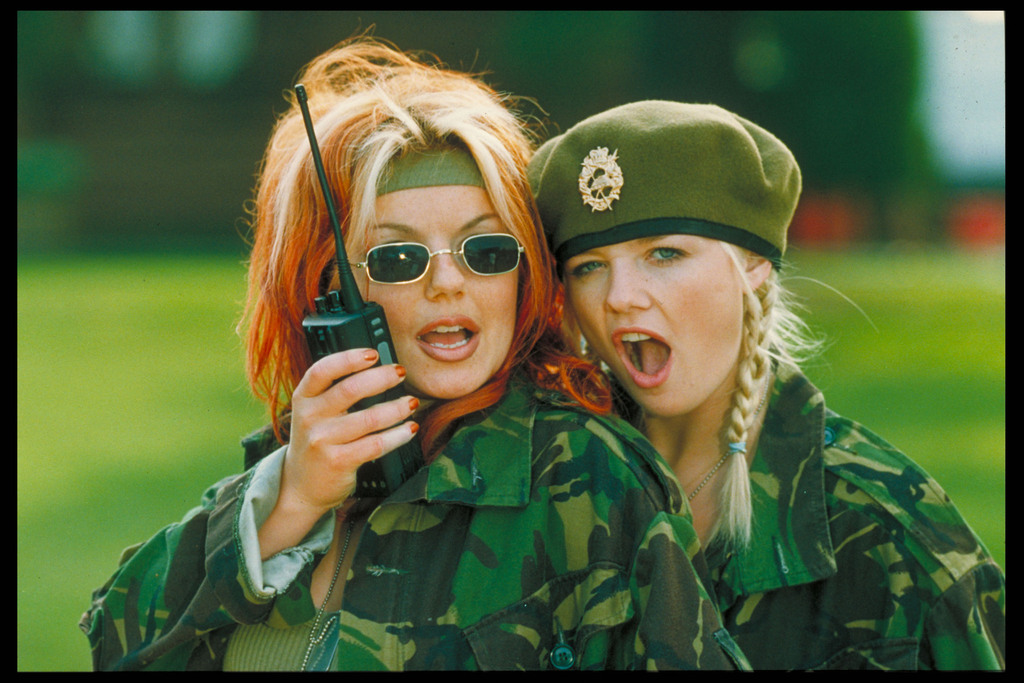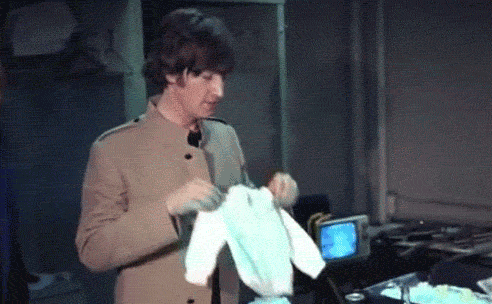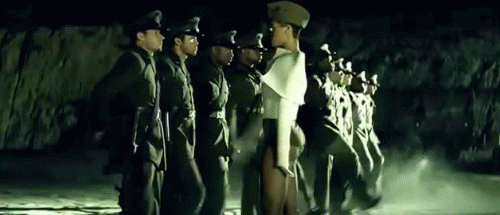Is Adopting Military Wear In Fashion Disrespectful, Or Legitimate Cultural Expression?
Fashion and war wear have a long, frequently fraught history. What are the ethics of donning a bomber jacket or fast fashion fatigues?


Brought to you by Miss Shop Myer
Miss Shop girls are running the show this season, and we teamed up with them to explore the history behind five iconic looks. Run With Us here.
–
Fashion and the military have a long and complicated history — reaching back long before Hugo Boss was sketching uniforms for the Nazis — and there are a few very different schools of thought on the appropriation of military uniforms for fashion trends. The first follows similar lines as the questions raised around the mass-produced faux-Native American headdresses being banned from music festivals, and sound a lot like the very vocal issues my nan still has with Madonna wearing a crucifix (she hasn’t seen Madonna since 1992 and you know, that’s probably a good thing). This argument goes that using serious cultural/ceremonial accoutrements like military stripes and medals demeans the sacrifices and honour these sartorial talismans represent.
However, the case for civilians wearing military dress for fashion or other non-military purposes has a number of creditable arguments of its own. One goes that wearing military outfits can be a powerful but peaceful form of protest; a phenomenon that took off in the Vietnam war era when young people in the antiwar movement wore fatigues, camouflage, army jackets and cargo pants at public demonstrations.

Another school of thought views fashion as an important art form – as valid as music and visual art – and that means that, just like those other mediums, appropriation and borrowing from different cultures, creeds and regalia isn’t just an inevitable part of design evolution; it can be important as well as beautiful.
Queensland University of Technology fashion lecturer Alice Payne puts it like this: “When you see it in the street, you don’t even know if it’s a genuine jacket from a military surplus store or if it’s just fast fashion. Unless it uses symbols from current world conflicts, I don’t think anyone should have a problem. People are wearing it for the history just like punks wearing patches, for grunge, and most of all simply for how it looks.”
Regardless of which side of the debate you find yourself on, the history of military style in fashion is a long and fascinating one. Let’s take a look.
–
The Reappropriation Of War Wear
Fashion houses today are full of enough technicolor thread to make a thousand dream-coats, but during wartime uniforms were purely the product of utility and availability.To put the red in the American Revolutionary War redcoats wasn’t an aesthetic choice but the result of a ready supply of root vegetable dye Madder. Meanwhile the toffs in their dress uniforms demanded a brighter red, dying their coats with cochineal, an insect that eats cactuses and secretes a crimson dye. I guess ‘redcoats’ was a more impressive title that ‘poopy bug coats’. Likewise, the emergence of what we mostly think of as army green was in fact ‘Olive Green 107’, chosen for the M-65 field jacket worn by US troops for its versatile powers of camouflage.
Rationing of fabric during WWII under the Utility Clothing Scheme meant all uniforms and clothing became boxy and minimalist. As a show of solidarity and patriotism, men were told to wear their uniforms on home turf as well as the front lines. Any man seen in civvies was considered to be a conscientious objector and women were encouraged to publicly shame them by handing them white feathers, which is actually a pretty lovely way to flip someone the bird.

Speaking of, Vietnam protesters had a non-verbal way of communicating their counterculture message to the squares: wearing military clothing on marches allowed them to malign the very symbol that the establishment had filled with power and patriotism.
Just as some scour the op shops of today for deleted Smiths singles and vintage threads, the in-crowd of the sixties in London were reviving a look from the turn of the century. World War II was too fresh to satirise, so they looked back to earlier conflicts with more elaborate uniforms. The public were aghast, with one newspaper reporting: “Lord Kitchener of Khartoum would undoubtedly turn in his grave if he knew that he was giving his name to a ‘with it’ boutique in London’s Portobello Road … selling the uniform of the British Army as the latest ‘mod’ gear.”
Jimi Hendrix was also prowling around London by then, having previously spent time in the US Army, where he trained as a paratrooper and was awarded the Screaming Eagles patch of the 101st Airborne Division. In his collection of writings Starting at Zero he recalls being roughed up by the British police while wearing a jacket from the 1898 Royal Army Veterinary Corps.
“That’s British, isn’t it?” Hendrix was asked.“You’re not supposed to be wearing that. Men fought and died in that uniform.”
–
Military Fashion Today: Shocking Or Harmless?
Wearing military apparel doesn’t deserve you a beating, but is it something to avoid? Dawnn Karen, fashion psychology lecturer at the Fashion Institute of Technology, New York, says the ubiquity of fashion labels appropriating the military look has made that historic shock value wear off to a large extent:
“The power to shock nowadays might exist in some regions, but in New York military apparel is in every store. It’s in Urban Outfitters, so it’s ubiquitous. A lot of musicians like Beyoncé have made it popular, and you might feel a sort of patriotism when you’re donning it.”

According to Karen, civilians nowadays will put more stock in how military-style clothing makes them feel personally than in any historical significance. “A hoodie swallows you: you feel incognito … or mysterious [and] you don’t want to be seen.”
A military jacket on the other hand inspires confidence, chosen “when you want a stark clean look that makes you feel invincible. It gives you a powerful in-charge persona.”
So whether it’s the bad guys in the next Hunger Games-esque franchise or Beyoncé fans in glittery epaulettes, you can be sure civilian military will continue to turn up in lines over and again.
–
Join the movement at #werunthis.
–
Matthias escaped South America alive, wronged a good woman and forgot the movie song.